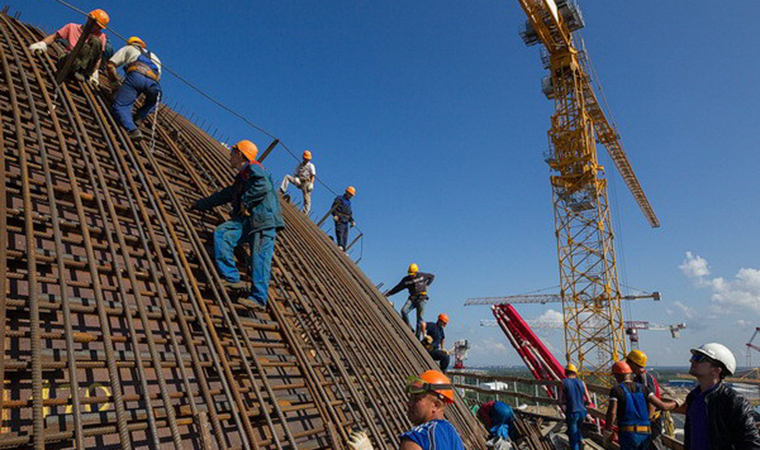
Construction goes at full speed
back to contentsA 330-ton reactor vessel was installed in the reactor pit at Novovoronezh NPP-2 Unit Two. Installation of the mammoth piece of equipment was split into two stages. First, the vessel was lifted with the crane and lowered onto a special flatcar to be transported by rail into containment. Then a polar crane moved it into position on the bottom support ring in the reactor pit.
Installation of the reactor vessel represents a milestone in the construction of the power unit. The next step is welding the main circulation system for the reactor. The Central Machine Building Design Bureau has already manufactured components, fittings and accessories for removable assemblies of the main circulation pumps, and shipped them to Novovoronezh NPP-2, bringing the reactor startup much closer.
The new generation VVER-1200 installed in Unit Two at Novovoronezh is the most powerful reactor in Russia. Its key advantages are high performance, long service life, and safety.
A little earlier, engineers at Energospetsmontazh (a Rosatom Group company specializing in the installation of nuclear and conventional power plants, mining equipment, and chemical plants) installed a pressurizer in the Unit Two reactor building. The pressurizer is a component of the reactor’s primary loop, which maintains the required pressure when the Unit is operating at full power and compensates for pressure changes during transients and in any emergency. It is a cylindrical vessel with an elliptical base that is placed vertically on the support ring.
In another recent development at Novovoronezh NPP-2, the makeup water system was tested just a few days ago. Four pumps will bring water from the Don River into the service water systems of the new units. The system functions as follows: before entering the NPP site, water flows through the cone-type fish protection screen to keep fish from getting into the piping. Then water flows into the cooling tower basin and, through the discharge canal and pumping unit, enters the Unit steam condenser as coolant. River water is also used for fire-fighting purposes.
105% performance
Leningrad NPP-2 reviews its performance in the first quarter of 2015. Construction was 5% ahead of the schedule.
Unit One was the top performer. Major developments in its construction include completion of the internal and external containment concreting, installation of the spent fuel pool liner and floor sheeting.
A concrete ceiling slab was installed over the tank rooms in the auxiliary building. Two LDF filters were installed into the condensate iron removal and desalination system in the turbine hall. Auxiliary structures of the external containment dome at Unit One are scheduled for concreting in the near future.
In April, ZiO-Podolsk (a subsidiary of Atomenergomash, Rosatom’s nuclear engineering division) shipped the last (fourth) steam generator for Unit Two at the Leningrad NPP-2.
The steam generators are designed to work with VVER-1200 reactors. Their key function is to remove heat from the primary loop coolant and generate dry saturated steam. With four steam generators, the installed capacity of the power unit will reach 1,200 MW. The steam generators belong to Nuclear Safety Class 1 and have a long manufacturing lead time, which was reduced by ZiO-Podolsk engineers from 247 to 226 days. Weighing about 430 tons, the steam generator was delivered to Leningrad NPP-2 in a combined mode – by land and by water.
Construction site near Volgodonsk
Installation of steel structures and the bottom support ring of the dome have been completed at the Rostov NPP Unit Four. A water expansion tank for the steam generators was installed in its permanent location inside the extension of the main building. Work to install the radioactive drain and to line the spent fuel pool is ongoing.
The spent fuel pool is designed for the temporary storage of spent nuclear fuel from the reactor core in order to remove excessive radioactivity and residual heat, and for the conditioning of fresh fuel assemblies before they are loaded into the core.
The reactor vessel is expected to be delivered to the construction site in the second quarter of 2015.
Also in progress at Unit Four, which is under construction, is testing of the polar crane in preparation for putting it into operation. The crane will handle all loading and unloading tasks at any point of the reactor building as it moves along a circular path. It will be used to install all of the heavy equipment, including the reactor.
In the meantime, Rostov Unit Three, which went critical late last year, is being prepared to run in the pilot operation mode. This was announced by Alexander Vologdin, Deputy CEO of Atomtekhenergo, at a meeting of the Construction Management Team. “We are now performing startup testing activities and checks as part of the pilot operation stage,” said Mr. Vologdin.
Commercial operation of Unit Three is scheduled to start in July 2015, followed by Unit Four in 2017.
Commercial operation not far off
The world is watching closely the pilot operation of a BN-800 fast reactor at Beloyarsk NPP. The reactor was started quite long ago. However, no one is in a hurry to begin commercial operation since its equipment is unique. According to the CEO of Rosenergoatom, the operator of Russian nuclear power plants, commercial operation might begin in the second half of 2015.
“This year is 100% sure. I do not think it will be the first half of the year – that is too optimistic, and we have not yet resolved all of the safety issues. However, we are interested in doing it as soon as possible,” said Mr. Romanov.
He added that the current priority was to complete all of the safety related tasks and to settle all issues with the regulator.
“There were no delays in the reactor startup. Adjustments are needed before we start commercial operation,” said Mr. Romanov.




